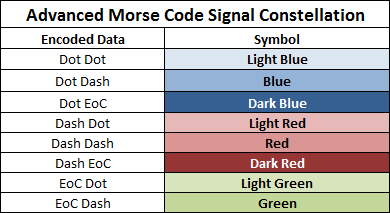In December 2012, I was award an MS in ECE. My focus was in telecommunications. After learning this, an acquaintance asked me to explain what telecom is. I think I might have gotten the highlights of the field across to her, but it wasn't as easy as I had hoped. This series of posts is dedicated to explaining the basics of telecom as simply as possible.
Modulation
A modulation scheme is a mapping of the data you want to send to the electrical signal you transmit representing that data. Binary phase shift keying is a very basic modulation scheme in which a sine wave with a phase of 0 degrees represents a binary 1 and a sine wave with a phase of 180 degrees represents a binary 0.
If you're sending data as quickly as you can across some medium (telephone wire, coaxial cable, etc.), modulation schemes let you send more data across the line without using any extra bandwidth. There are limits on how many symbols you can transmit each second. (This limit is determined by the bandwidth of the channel you're using to transmit your data.) If you're clever you can send data more quickly without using any extra bandwidth by choosing the right modulation scheme.
Modulation Example
Imagine you've invented a secret code with one of your friends. You and your friend live in two houses across the city from each other with a clear line of sight. You want to send a message to your friend. Your current code for sending messages is a variant on Morse code. You hold up a white sheet of paper for a 'dot', a black sheet of paper for a 'dash', and a gray sheet of paper at the end of each character.

Each second, you hold up the next sheet of paper for your message. If your message is "hello", or .... . .-.. .-.. ---, then it would take 20 seconds to send your message. Four seconds for "h", one for "e", four for "l", four for "l", three for "o", and four for the pauses between each letter (4+1+4+4+3+4=20).

This solution is slow! It would take over a minute just to ask "how are you doing?" One way to speed this up would be to show two cards per second, but that's hard to do by hand. Another way to speed up our messages is by sending two "dots" or "dashes" with each card we hold up. How? Add more colors to our collection!

Now with our advanced modulation scheme we can send messages twice as fast. It only takes 10 seconds to say "hello"!

There are a couple of metrics we can use to compare these two modulation schemes: intersymbol distance, and bits-per-symbol. These metrics allow telecom engineers to compare modulation schemes and pick the best one for a particular situation.
Intersymbol Distance
Intersymbol distance is a measure of how different two symbols look. In the case of the advanced modulation scheme, the difference between light-red and red is very slight. In poor lighting it would be almost impossible to differentiate these two symbols. Due to the small intersymbol distance of the advanced modulation scheme, we could expect the receiver to make many errors when receiving a message (in telecom papers, this is called the bit-error-rate). If we changed our modulation scheme to use colors that are more obviously different from each other, the intersymbol distance would be increased and the bit-error-rate would decrease.
Bits per Symbol
Bits per symbol is a more straightforward metric. It's a measure of how much data can be transmitted by a single symbol. The advanced Morse code modulation scheme transmits twice the number of bits per symbol. With a constant signaling rate, or baud, the advanced modulation scheme sends messages twice as fast.
The beautiful part of modulation schemes is you can switch between them at will! If the sun has set and it's difficult to tell blue from green, switch to the basic modulation scheme. Your messages will take longer to transmit, but you can be more certain that they arrive at their destination without error!
Modulation Schemes in Practice
Again, if you look at the theoretical speeds for IEEE 802.11ac, you can see how modulation schemes affect transmission rates. The modulation scheme is denoted as the "modulation type" and the number of symbols used by each modulation scheme is denoted by the number. (BPSK uses 2 symbols, QPSK uses 4, 16-QAM uses 16, 64-QAM uses 64, and 256-QAM uses 256.) Moving down the table increases the the number of symbols in the modulation scheme (and increases the coding rate, but that's a story for the next post), and an increase in throughput results (without using any extra bandwidth!)
Photo of the Arecibo Observatory by H. Schweiker/WIYN and NOAO/AURA/NSF